Small overlap front: driver-side
Rating applies to 2014-15 models
Tested vehicle: 2014 Chevrolet Malibu 1LT 4-door
The Chevrolet Malibu was redesigned for the 2013 model year. Beginning with 2014 models, the front structure and door sill were modified to improve occupant protection in small overlap frontal crashes.
For the 2016 model year only, the Malibu was renamed the Malibu Limited and sold when new only to fleets. The Malibu Limited shares no ratings with the redesigned 2016 Chevrolet Malibu.
| Overall evaluation | |
|---|---|
| Structure and safety cage | |
| Driver injury measures | |
| Head/neck | |
| Chest | |
| Hip/thigh | |
| Lower leg/foot | |
| Driver restraints and dummy kinematics |
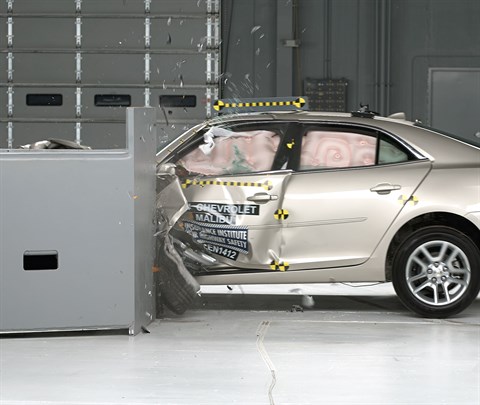
Action shot taken during the small overlap frontal crash test.
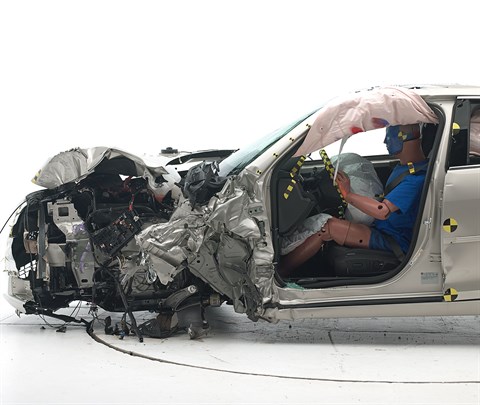
The dummy's position in relation to the door frame, steering wheel, and instrument panel after the crash test indicates that the driver's survival space was maintained very well.
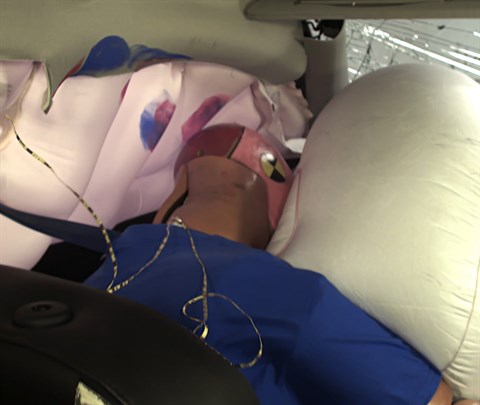
The frontal and side curtain airbags worked well together to keep the head from coming close to any stiff structure or outside objects that could cause injury.
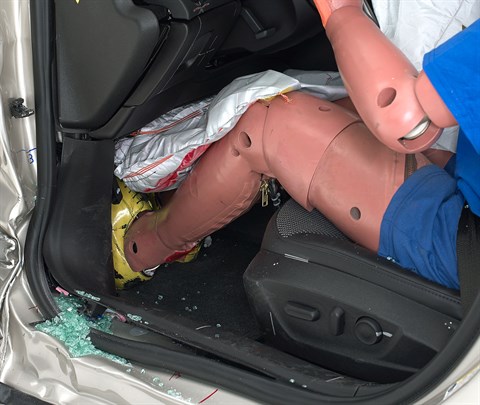
Intrusion into the driver's space was minimal, and risk of injuries to the dummy's legs and feet was low.
Measures of occupant compartment intrusion on driver side
| Test ID | CEN1412 |
|---|---|
| Lower occupant compartment | |
| Lower hinge pillar max (cm) | 8 |
| Footrest (cm) | 9 |
| Left toepan (cm) | 4 |
| Brake pedal (cm) | 3 |
| Parking brake (cm) | |
| Rocker panel lateral average (cm) | 2 |
| Upper occupant compartment | |
| Steering column | 2 |
| Upper hinge pillar max (cm) | 5 |
| Upper dash (cm) | 6 |
| Lower instrument panel (cm) | 6 |
Driver injury measures
| Test ID | CEN1412 |
|---|---|
| Head | |
| HIC-15 | 112 |
| Peak gs at hard contact | no contact |
| Neck | |
| Tension (kN) | 1.0 |
| Extension bending moment (Nm) | 11 |
| Maximum Nij | 0.16 |
| Chest maximum compression (mm) | 19 |
| Femur (kN) | |
| Left | 1.2 |
| Right | 0.0 |
| Knee displacement (mm) | |
| Left | 1 |
| Right | 0 |
| Knee-thigh-hip injury risk (%) | |
| Left | 0 |
| Right | 0 |
| Maximum tibia index | |
| Left | 0.58 |
| Right | 0.43 |
| Tibia axial force (kN) | |
| Left | 2.9 |
| Right | 0.7 |
| Foot acceleration (g) | |
| Left | 110 |
| Right | 51 |
Moderate overlap front: original test
Rating applies to 2013-15 models
Tested vehicle: 2013 Chevrolet Malibu Eco 4-door
The Chevrolet Malibu was redesigned for the 2013 model year. For the 2016 model year only, the Malibu was renamed the Malibu Limited and sold when new only to fleets. The Malibu Limited shares no ratings with the redesigned 2016 Chevrolet Malibu.
Moderate overlap frontal ratings are assigned by the Institute based on a test conducted by General Motors as part of frontal crash test verification.
| Overall evaluation | |
|---|---|
| Structure and safety cage | |
| Driver injury measures | |
| Head/neck | |
| Chest | |
| Leg/foot, left | |
| Leg/foot, right | |
| Driver restraints and dummy kinematics |
Measures of occupant compartment intrusion on driver side
| Test ID | VTF1114 |
|---|---|
| Footwell intrusion | |
| Footrest (cm) | 3 |
| Left (cm) | 5 |
| Center (cm) | 6 |
| Right (cm) | 5 |
| Brake pedal (cm) | 2 |
| Instrument panel rearward movement | |
| Left (cm) | 0 |
| Right (cm) | 0 |
| Steering column movement | |
| Upward (cm) | 0 |
| Rearward (cm) | -6 |
| A-pillar rearward movement (cm) | 1 |
Driver injury measures
| Test ID | VTF1114 |
|---|---|
| Head | |
| HIC-15 | 327 |
| Peak gs at hard contact | no contact |
| Neck | |
| Tension (kN) | 0.8 |
| Extension bending moment (Nm) | 25 |
| Maximum Nij | 0.26 |
| Chest maximum compression (mm) | 26 |
| Legs | |
| Femur force - left (kN) | 0.5 |
| Femur force - right (kN) | 0.9 |
| Knee displacement - left (mm) | 1 |
| Knee displacement - right (mm) | 1 |
| Maximum tibia index - left | 0.33 |
| Maximum tibia index - right | 0.31 |
| Tibia axial force - left (kN) | 2.2 |
| Tibia axial force - right (kN) | 2.6 |
| Foot acceleration (g) | |
| Left | 51 |
| Right | 58 |
Side: original test
Rating applies to 2013-15 models
Tested vehicle: 2013 Chevrolet Malibu Eco 4-door with standard front and rear head curtain airbags and standard front seat-mounted torso airbags
The Chevrolet Malibu was redesigned for the 2013 model year. Initially, only the Eco model (a hybrid with a gasoline engine and an electric motor powered by a lithium-ion battery) was available in the new design. Other Malibu models with conventional powertrains were introduced later, when side torso airbags for rear seat occupants were made standard (they had been optional earlier). All Malibu models built after July 2012 have the standard rear side torso airbags. (Information about when a specific vehicle was manufactured is on the certification label typically affixed to the car on the driver door or adjacent B-pillar.)
Two side tests of the Malibu Eco were initially conducted, one by the Institute and one by General Motors as part of side crash test verification. Neither car had the optional rear side torso airbags. A third test, this time of a Malibu LTZ with the standard rear side torso airbags, was then conducted by General Motors. Rear seat dummy torso injury measures improved for the third car, but each of the three tests produced good injury ratings for the rear seat dummies. Therefore, the ratings below are based on all three tests. Photos and videos are provided for the Institute test car.
For the 2016 model year only, the Malibu was renamed the Malibu Limited and sold when new only to fleets. The Malibu Limited shares no ratings with the redesigned 2016 Chevrolet Malibu.
| Overall evaluation | |
|---|---|
| Structure and safety cage | |
| Driver injury measures | |
| Head/neck | |
| Torso | |
| Pelvis/leg | |
| Driver head protection | |
| Rear passenger injury measures | |
| Head/neck | |
| Torso | |
| Pelvis/leg | |
| Rear passenger head protection | |
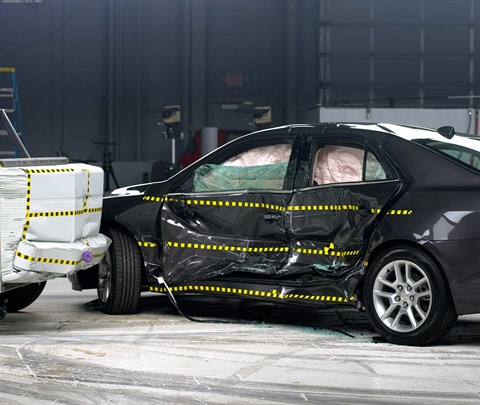
View of the vehicle and barrier just after the Institute's crash test.
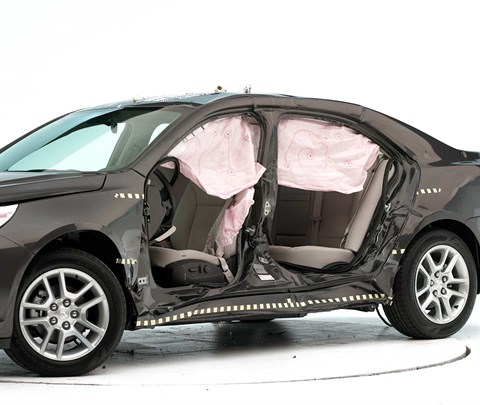
View of the vehicle after the crash with doors removed, showing the side airbags and damage to the occupant compartment.
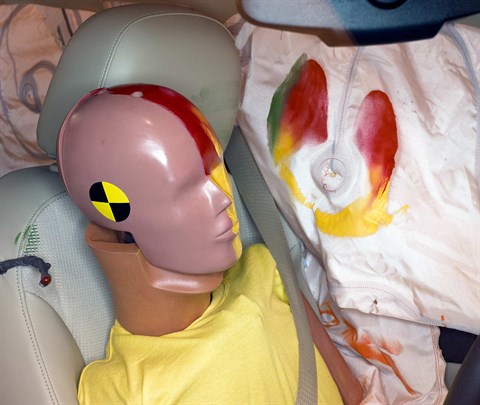
Smeared greasepaint shows where the driver dummy's head was protected from being hit by hard structures by the side curtain airbag in the Institute's test.
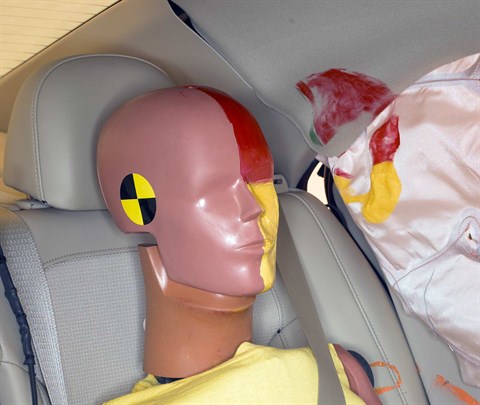
Smeared greasepaint shows where the rear passenger dummy’s head was protected by the side airbag.
Measures of occupant compartment intrusion on driver side
| Test ID | VTS1116 | CES1205 | VTS1204 |
|---|---|---|---|
| B-pillar to longitudinal centerline of driver's seat (cm) | -15.5 | -16.5 | -18.0 |
| Negative numbers indicate the amount by which the crush stopped short of the seat centerline. | |||
Driver injury measures
| Test ID | VTS1116 | CES1205 | VTS1204 |
|---|---|---|---|
| Head HIC-15 | 440 | 310 | 390 |
| Neck | |||
| Tension (kN) | 1.4 | 1.3 | 1.2 |
| Compression (kN) | 0.2 | 0.2 | 0.2 |
| Shoulder | |||
| Lateral deflection (mm) | 50 | 40 | 43 |
| Lateral force (kN) | 1.6 | 1.6 | 1.8 |
| Torso | |||
| Maximum deflection (mm) | 41 | 44 | 45 |
| Average deflection (mm) | 36 | 35 | 40 |
| Maximum deflection rate (m/s) | 4.21 | 3.65 | 5.24 |
| Maximum viscous criterion (m/s) | 0.66 | 0.68 | 0.79 |
| Pelvis | |||
| Iliac force (kN) | 2.2 | 1.8 | 1.2 |
| Acetabulum force (kN) | 3.3 | 2.1 | 2.7 |
| Combined force (kN) | 4.9 | 3.5 | 3.7 |
| Left femur | |||
| L-M force (kN) | 1.0 | 0.9 | 0.7 |
| L-M moment (Nm) | 31 | 58 | 22 |
| A-P moment (Nm) | 126 | -33 | 99 |
Passenger injury measures
| Test ID | VTS1116 | CES1205 | VTS1204 |
|---|---|---|---|
| Head HIC-15 | 330 | 310 | 140 |
| Neck | |||
| Tension (kN) | 0.4 | 0.2 | 0.2 |
| Compression (kN) | 0.6 | 0.8 | 0.7 |
| Shoulder | |||
| Lateral deflection (mm) | 44 | 32 | 13 |
| Lateral force (kN) | 1.6 | 1.1 | 0.8 |
| Torso | |||
| Maximum deflection (mm) | 41 | 30 | 20 |
| Average deflection (mm) | 32 | 23 | 16 |
| Maximum deflection rate (m/s) | 3.64 | 3.48 | 2.39 |
| Maximum viscous criterion (m/s) | 0.64 | 0.32 | 0.18 |
| Pelvis | |||
| Iliac force (kN) | 0.4 | 0.2 | 0.2 |
| Acetabulum force (kN) | 2.1 | 1.8 | 1.7 |
| Combined force (kN) | 2.4 | 1.9 | 1.9 |
| Left femur | |||
| L-M force (kN) | 0.7 | 0.4 | 0.5 |
| L-M moment (Nm) | 18 | 128 | 50 |
| A-P moment (Nm) | 68 | -92 | 98 |
Roof strength
Rating applies to 2013-15 models
Tested vehicle: 2013 Chevrolet Malibu Eco 4-door
For the 2016 model year only, the Malibu was renamed the Malibu Limited. Its roof rating is shared with 2013-15 models of the Malibu.
| Overall evaluation | |
|---|---|
| Curb weight | 3,583 lbs |
| Peak force | 18,721 lbs |
| Strength-to-weight ratio | 5.22 |
Head restraints & seats
Seat type: Manual power cloth seat
| Overall evaluation | |
|---|---|
| Dynamic rating | |
| Seat/head restraint geometry |
| Seat type | Manual power cloth seat |
|---|---|
| Geometry | |
| Backset (mm) | 26 |
| Distance below top of head (mm) | 9 |
| Seat design parameters | |
| Pass/fail | Pass |
| Max T1 acceleration (g) | 12.3 |
| Head contact time (ms) | 56 |
| Force rating | 1 |
| Neck forces | |
| Max neck shear force (N) | 0 |
| Max neck tension (N) | 300 |
How the head restraint & seat test is conducted
Currently, IIHS tests apply only to front seats.
Headlights
Ratings are given for 3 different headlight variations available on this vehicle.
Trim level(s)
-
LTZ trim equipped with Premium package
| Low-beam headlight type | HID projector |
|---|---|
| High-beam headlight type | HID reflector |
| Curve-adaptive? | No |
| High-beam assist? | No |
| Overall rating |
|
| Distance at which headlights provide at least 5 lux illumination: | |
Low beams
On the straightaway, visibility was fair on both sides of the road. On curves, visibility was inadequate in all 4 tests.
The low beams never exceeded glare limits.
High beams
On the straightaway, visibility was inadequate on both sides of the road. On curves, visibility was inadequate in all 4 tests.
| Trim level(s) |
|
|---|---|
| Low-beam headlight type | HID projector |
| High-beam headlight type | HID reflector |
| Curve-adaptive? | No |
| High-beam assist? | No |
| Overall rating Applies to 2015 models |
| LOW BEAMS | Average minimum useful illumination distance (5 lux) |
Amount glare exceeded threshold |
|---|---|---|
| Straightaway right edge | 92.4 m | None |
| Straightaway left edge | 46.8 m | None |
| 250m radius right curve, right edge | 53.3 m | None |
| 250m radius left curve, left edge | 43.3 m | None |
| 150m radius right curve, right edge | 37.6 m | None |
| 150m radius left curve, left edge | 36.1 m | None |
| HIGH BEAMS | Average minimum useful illumination distance (5 lux) |
|---|---|
| Straightaway right edge | 107.0 m |
| Straightaway left edge | 103.6 m |
| 250m radius right curve, right edge | 54.9 m |
| 250m radius left curve, left edge | 59.2 m |
| 150m radius right curve, right edge | 40.6 m |
| 150m radius left curve, left edge | 42.8 m |
Trim level(s)
-
LT trim
-
LTZ trim
| Low-beam headlight type | Halogen projector |
|---|---|
| High-beam headlight type | Halogen reflector |
| Curve-adaptive? | No |
| High-beam assist? | No |
| Overall rating |
|
| Distance at which headlights provide at least 5 lux illumination: | |
Low beams
On the straightaway, visibility was inadequate on both sides of the road. On curves, visibility was inadequate in all 4 tests.
The low beams never exceeded glare limits.
High beams
On the straightaway, visibility was good on the right side of the road and fair on the left side. On curves, visibility was inadequate in all 4 tests.
| Trim level(s) |
|
|---|---|
| Low-beam headlight type | Halogen projector |
| High-beam headlight type | Halogen reflector |
| Curve-adaptive? | No |
| High-beam assist? | No |
| Overall rating Applies to 2015 models |
| LOW BEAMS | Average minimum useful illumination distance (5 lux) |
Amount glare exceeded threshold |
|---|---|---|
| Straightaway right edge | 74.7 m | None |
| Straightaway left edge | 32.8 m | None |
| 250m radius right curve, right edge | 42.2 m | None |
| 250m radius left curve, left edge | 35.1 m | None |
| 150m radius right curve, right edge | 38.5 m | None |
| 150m radius left curve, left edge | 32.2 m | None |
| HIGH BEAMS | Average minimum useful illumination distance (5 lux) |
|---|---|
| Straightaway right edge | 147.3 m |
| Straightaway left edge | 131.1 m |
| 250m radius right curve, right edge | 60.8 m |
| 250m radius left curve, left edge | 62.7 m |
| 150m radius right curve, right edge | 47.0 m |
| 150m radius left curve, left edge | 47.9 m |
Trim level(s)
-
LS trim
| Low-beam headlight type | Halogen reflector |
|---|---|
| High-beam headlight type | Halogen reflector |
| Curve-adaptive? | No |
| High-beam assist? | No |
| Overall rating |
|
| Distance at which headlights provide at least 5 lux illumination: | |
Low beams
On the straightaway, visibility was inadequate on both sides of the road. On curves, visibility was inadequate in all 4 tests.
The low beams never exceeded glare limits.
High beams
On the straightaway, visibility was good on the left side of the road and fair on the right side. On curves, visibility was inadequate in all 4 tests.
| Trim level(s) |
|
|---|---|
| Low-beam headlight type | Halogen reflector |
| High-beam headlight type | Halogen reflector |
| Curve-adaptive? | No |
| High-beam assist? | No |
| Overall rating Applies to 2015 models |
| LOW BEAMS | Average minimum useful illumination distance (5 lux) |
Amount glare exceeded threshold |
|---|---|---|
| Straightaway right edge | 66.3 m | None |
| Straightaway left edge | 33.7 m | None |
| 250m radius right curve, right edge | 44.9 m | None |
| 250m radius left curve, left edge | 36.5 m | None |
| 150m radius right curve, right edge | 38.3 m | None |
| 150m radius left curve, left edge | 32.8 m | None |
| HIGH BEAMS | Average minimum useful illumination distance (5 lux) |
|---|---|
| Straightaway right edge | 140.9 m |
| Straightaway left edge | 144.7 m |
| 250m radius right curve, right edge | 58.5 m |
| 250m radius left curve, left edge | 59.9 m |
| 150m radius right curve, right edge | 44.3 m |
| 150m radius left curve, left edge | 46.3 m |
Front crash prevention: vehicle-to-vehicle
Child seat anchors
Rating applies to 2015 models
| Overall evaluation |
|
| Vehicle trim | 1LT |
| Seat type | leather |
This vehicle has 2 rear seating positions with complete child seat attachment (LATCH) hardware.
It has 1 additional seating position with a tether anchor, a single lower anchor and the ability to borrow the second anchor from another position.
Note: When anchors are borrowed, they aren't available to use in their designated positions.
| Overall evaluation |
|
| Vehicle trim | 1LT |
| Seat type | leather |
| G | Good |
| A | Acceptable |
| M | Marginal |
| P | Poor |
|
|
Seating positions that rely on borrowed lower anchors or have only a tether anchor available are not rated. |
|
thether anchor symbol
|
Tether anchor |
|
lower anchor symbol
|
Lower anchors |
| Lower anchor(s) can be borrowed from adjacent positions(s) | |
|
|
No hardware available |
Details by seating position
| 1 | |
|---|---|
| Tether anchor | |
| easy-to-find location | |
| no other hardware could be confused for anchor | |
| Lower anchors | |
| too deep in seat | |
| not too much force needed to attach | |
| easy to maneuver around anchors | |
| 2 | |
| Tether anchor | |
| easy-to-find location | |
| no other hardware could be confused for anchor | |
| Lower anchors | |
| 1 dedicated anchor and 1 that can be borrowed from seat 3 | |
| too deep in seat | |
| not too much force needed to attach | |
| easy to maneuver around anchors | |
| 3 | |
| Tether anchor | |
| easy-to-find location | |
| no other hardware could be confused for anchor | |
| Lower anchors | |
| too deep in seat | |
| not too much force needed to attach | |
| easy to maneuver around anchors |
Seat position 21
| Lower anchor A | |
|---|---|
| Open access rated | No |
| Depth (cm) | 2-4 |
| Force (lbs) | 15 |
| Clearance angle (degrees) | 61 |
| Lower anchor B | |
| Open access rated | No |
| Depth (cm) | 2-4 |
| Force (lbs) | 14 |
| Clearance angle (degrees) | 60 |
| Tether anchor | |
| Location | Rear deck |
| Confusing hardware present | No |
| Has contrasting label within 3 inches of tether anchor |
No |
Seat position 22
| Lower anchor A | |
|---|---|
| Lower latch is shared for this seat position | |
| Lower anchor B | |
| Open access rated | No |
| Depth (cm) | 4-6 |
| Force (lbs) | 14 |
| Clearance angle (degrees) | 61 |
| Tether anchor | |
| Location | Rear deck |
| Confusing hardware present | No |
| Has contrasting label within 3 inches of tether anchor |
No |
Seat position 23
| Lower anchor A | |
|---|---|
| Open access rated | No |
| Depth (cm) | 4-6 |
| Force (lbs) | 17 |
| Clearance angle (degrees) | 74 |
| Lower anchor B | |
| Open access rated | No |
| Depth (cm) | N/A |
| Force (lbs) | 11 |
| Clearance angle (degrees) | 74 |
| Tether anchor | |
| Location | Rear deck |
| Confusing hardware present | No |
| Has contrasting label within 3 inches of tether anchor |
No |
